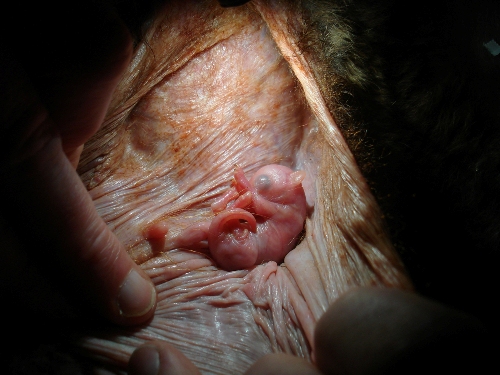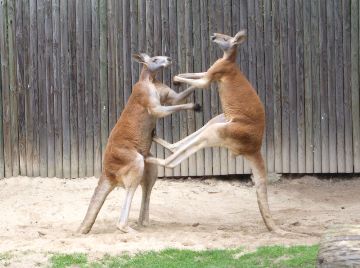Red Kangaroo (Macropus rufus)
Reproduction
Red Kangaroos undergo sexual reproduction, but one that is slightly
different from our own. This process begins with the female “coming into
heat,” or oestrus (Croft, 2010). While in heat, the female produce
chemicals that can be sensed by males from large distances away. Male
kangaroos will begin to conjugate around the female in order to be
chosen to mate with her. To try and prove a male’s superiority, they
will engage in what is referred to as “boxing” (Croft, 2010). Boxing is
a form of fighting used to establish ownership over a female for a short
period of time. During this, males will use their forearms to punch and
powerful hind legs to kick one another (Croft, 2010). Red kangaroos, due
to their larger size, have been seen wrestling as a way of boxing
(Croft, 2010). Once a mate has been chosen by the female, this male will
follow her very closely, occasionally grabbing at her tail until she is
ready to breed (Billabong Sanctuary, 2013). The male will periodically
check to see if the female is ready to breed by sniffing the area under
her tail or by smelling her urine (Billabong Sanctuary, 2013). Once the
two mate, the male will have nothing to do with the pregnancy and young
joey.
 The
new kangaroo, or joey, is born after just 32-34 days (Croft, 2010). The
tiny joey at birth is only a few centimeters long, and after birth it
crawls without help by its mother into its mother’s pouch (Croft, 2010).
After the joey has made the journey into the pouch, it will chose one of
4 nipples in the pouch and feed from it until it is large enough to fend
for itself (Billabong Sanctuary, 2013). There are many in-between stages
from birth to independence. For roughly the first 190 days, the young
joey will stay inside the pouch, feeding from its mother and never
venturing out of the pouch (Newsome, 1965). Around 190 days after birth,
the joey will make its first exit from the pouch, very briefly exploring
the world around it (Billabong Sanctuary, 2013). From this point on, the
joey will continue to make trips out of the pouch increasing in duration
as the joeys grows. Eventually, the joey will become too heavy to return
to the pouch and will instead stick very close to the mother, still
being fed by its mother via her milk (Newsome, 1965). Four months or so
after having permanently left the pouch, the joey will begin being
weaned from the female’s milk and expected to fend for itself (Billabong
Sanctuary, 2013). Once weaned off and completely independent, males will
leave their mother and establish their own home range, talked about in
depth in the Habitat & Interactions page, while female joeys will stay
with their mom and other females (Newsome, 1965).
The
new kangaroo, or joey, is born after just 32-34 days (Croft, 2010). The
tiny joey at birth is only a few centimeters long, and after birth it
crawls without help by its mother into its mother’s pouch (Croft, 2010).
After the joey has made the journey into the pouch, it will chose one of
4 nipples in the pouch and feed from it until it is large enough to fend
for itself (Billabong Sanctuary, 2013). There are many in-between stages
from birth to independence. For roughly the first 190 days, the young
joey will stay inside the pouch, feeding from its mother and never
venturing out of the pouch (Newsome, 1965). Around 190 days after birth,
the joey will make its first exit from the pouch, very briefly exploring
the world around it (Billabong Sanctuary, 2013). From this point on, the
joey will continue to make trips out of the pouch increasing in duration
as the joeys grows. Eventually, the joey will become too heavy to return
to the pouch and will instead stick very close to the mother, still
being fed by its mother via her milk (Newsome, 1965). Four months or so
after having permanently left the pouch, the joey will begin being
weaned from the female’s milk and expected to fend for itself (Billabong
Sanctuary, 2013). Once weaned off and completely independent, males will
leave their mother and establish their own home range, talked about in
depth in the Habitat & Interactions page, while female joeys will stay
with their mom and other females (Newsome, 1965).
Female kangaroos also posses a very unique reproductive characteristic,
known as embryonic diapause.
Embryonic diapause refers to the female’s
ability to become pregnant very shortly after she has given birth to a
newborn (Croft, 2010). However, while the newborn joey matures in the
pouch, this freshly fertilized egg does not begin maturation in any
sense until the joey in the pouch either dies or leaves the pouch
(Croft, 2010). This process allows for very aggressive reproduction if
conditions are favorable for a period of time, which greatly assists in
survival of the species.
To return to Home Page click here